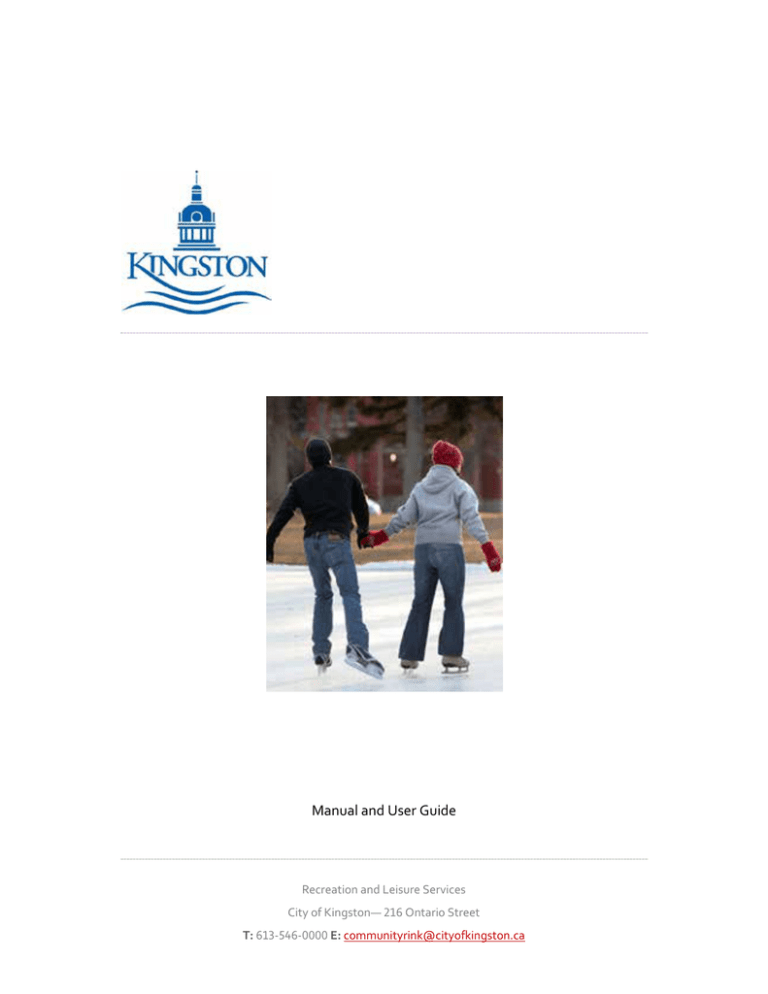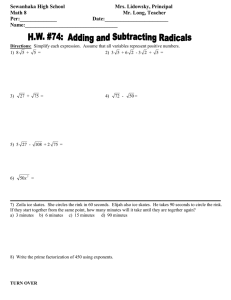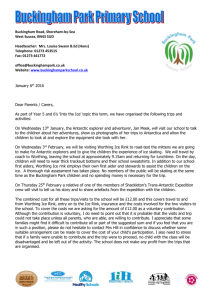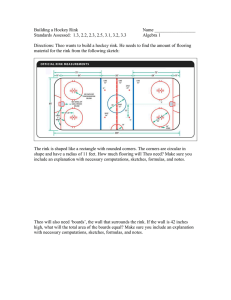City of Kingston - Recreation
advertisement

Manual and User Guide Recreation and Leisure Services City of Kingston— 216 Ontario Street T: 613-546-0000 E: communityrink@cityofkingston.ca |2 TABLE OF CONTENTS Purpose of this Guide 3 Section One: Getting Started 3 Section Two: Standard Operating Procedures 3 Rink Size Site Surfaces Ice Building and Maintenance Assistance and Advice Provided by the City Section Three: Rink Rules Rink Access Rink Tidiness Rink Inspections Section Four: Equipment Care of Equipment Equipment Provided by the City Section Five: Training Training Checklist Health and Safety Procedures Working in Cold Temperatures Lifting Techniques 3 3 4 5 6 6 6 6 7 7 7 8 8 8 8 9 Section Six: Accidents and Property Damage 10 When to report an accident Submitting an Accident/Incident Form Reporting Serious Accidents or Major Property Damage 10 10 10 |3 Purpose of this Guide This guide provides: 1. instructions and forms for making application to the City to establish a community outdoor rink 2. instructions to an approved Volunteer Team to build and maintain a community outdoor rink on municipal land, including standard operating procedures, training and health and safety standards Section One: Getting Started 1. Establish a Volunteer Team consisting of a minimum of four adults. Designate a principal contact to be the liaison between the Volunteer Team and the City. 2. Complete the expression of interest form, application form and the volunteer team form and submit to the City by email communityrink@cityofkingston.ca no later than November 1 for the following season. 3. Meet with the City to discuss the proposed rink, including intended use of rink (pleasure skating or hockey), location and the level of interest of neighbourhood residents in the proposed ice rink. The City will contact you to arrange a mutually agreeable time, upon receipt of the above forms. 4. Coordinate a community consultation meeting to demonstrate and confirm community support for the proposed rink. The City will assist you with this process, as required. Submit the community consultation agreement form to the City once the community consultation process is complete. Section Two: Standard Operating Procedures Rink Size 1. All rinks should be approximately 18 metres by 12 metres, or as determined by the City. Site Surfaces 2. Outdoor rinks are recommended on green spaces. 3. Outdoor rinks are not permitted on: a. any type of sports field (including tennis courts) b. any concrete or asphalt surface (parking lots or other) c. any body of water (ponds, lakes, rivers or other) |4 Ice Building and Maintenance HOW TO APPLY THE FIRST SHEET OF ICE 4. The process of building a rink should not begin before there is sufficient frost in the ground, which typically requires seven to ten consecutive days of minus ten degrees Celsius or lower. The rink may not be opened before the third week of December (weather permitting). 5. Make sure you are wearing all the proper safety gear needed for this task, including safety boots, safety glasses, gloves and safety helmet. 6. Clear the surface thoroughly of all snow and allow ground to freeze. 7. Initial floods should be applied heavily allowing water to pool slightly in lower areas. 8. Once these pooled areas have frozen sufficiently, start flooding again. You should be able to walk on pools without cracking or breaking the ice. 9. Water should now be applied evenly to entire surface, spreading water from side to side, walking backwards away from fresh floods. 10. Allow each flood to sufficiently freeze so that walking on it does not crack or break it. 11. Continue to apply water in light even sheets, until sufficient thickness is achieved. Ensure there are no dark areas where you can still see ground (surface must be white). Once area is covered properly with ice, skating will help to smooth out little bumps. FLOODING AND MAINTAINING THE ICE SURFACE 12. Scrape and clean snow, ice chips, flakes and dirt before flooding. The cleaner the ice surface, the smoother the surface when flooding. 13. Pull hose to the far end of the rink, then flood moving backward. 14. Flood as often as possible, ideally when the weather is coldest. Make sure that each layer is frozen before flooding again. The more floods the better, to sustain ice during mild periods. 15. Make sure the rink surface is thick enough to withstand the sun exposing patches of earth on milder days. 16. Do not allow the snow banks to get too high. Lower them by pushing the snow from the top away from the surface. 17. If using boards, check to make sure they do not become loose, especially during mild weather. Freeze them in place as soon as possible. 18. Volunteers may use motorized snow blowers to clear snow from the ice. |5 REPAIRING A CRACK, CHIP OR HOLE 19. If the ice becomes chipped or cracked or develops a hole, follow these repair instructions a. Sweep or clean the hole of snow or ice chips b. Prepare a slush mixture (snow and water) c. Pack the slush in the hole d. Level the slush with a shovel e. Sprinkle lightly with water f. Protect this area from skaters until frozen REPAIRING SHELL ICE 20. Shell ice can occur when an air bubble freezes to the ice surface and appears as a white, thin layer of ice that can be easily broken. To repair the shell ice, break and remove it and follow the instructions for repairing a crack, chip or hole above. Assistance and Advice Provided by the City 21. The City will provide reasonable assistance and advice during work hours on the following: a. Problems with nozzles and hoses b. Ice maintenance and weekly inspections c. Snow clearing as needed when snowfall accumulation is 15 cm or more and after all other municipal snow clearing priorities have been addressed d. Vandalism to ice surface or storage area |6 Section Three: Rink Rules Rink Access 1. Outdoor rinks must be made available to all those who wish to use them, in accordance with the specified rink type (pleasure skating or hockey), during allowable hours. 2. The City encourages Volunteer Teams to post a rink schedule, including opening and closure dates and times. 3. Volunteer Team members should prevent people from skating on the ice when it is mild in order to preserve the surface. If the ice is unsafe for use, the Volunteer Team members are responsible to close the rink. 4. Access to a rink may only be denied by the City to an individual or group for conduct that includes, but is not limited to: a. Abuse or harassment of park visitors, City staff or volunteers b. Destruction or vandalism of property c. Unsafe practices or behaviour that is in violation of law Rink Tidiness 5. Volunteer Teams have a responsibility to keep rink sites clean by picking up garbage and debris as part of their maintenance activities. 6. No smoking, alcohol or foul language is permitted on the ice or in the change room and/or washroom. Rink Inspections 7. Volunteer Teams will conduct daily inspections of ice surface and change rooms and/or washrooms to identify deficiencies, hazards and damages and to ensure site cleanliness and security. 8. Daily inspection log sheets must be completed and submitted to the City. 9. The City will conduct weekly inspections to check rink quality and overall tidiness and care. |7 Section Four: Equipment Care of Equipment 1. All equipment must be kept in a secure place when not in use. Never leave equipment out overnight. Never allow shovels or brooms to be left lying around. A light snowfall will hide them and increase the probability of loss or breakage. 2. Elevate the hose near the tap and drain excess water from the hose to minimize ice build-up near or in the storage area. While waiting between floods, place the hose in the snow bank away from surfaces. 3. Turn off the water completely when not in use. 4. Keep the storage area tidy at all times. 5. Turn off any lights in the skating or storage area, if equipped. 6. Do not leave the storage room unattended and lock it at the end of the evening or upon leaving the area. 7. Periodically check all equipment for damages and repair as required. 8. If the rink has been designated for hockey use, the Volunteers must supply, store and secure hockey nets and other related equipment. Don't allow them to be abused and when not in use, they should be removed from the ice surface. Place them in storage every night. The City is not responsible for this equipment. Equipment Provided by the City 9. The City will provide the following services and equipment to Volunteer Teams (this will be determined by the City). a. Rink boards (installed by the City at its discretion, generally for hockey rinks) b. Hose and nozzle c. Garbage cans and bags d. Signage (skate at own risk, or other) |8 Section Five: Training Training Checklist 1. The City will provide training to Volunteer Teams to clearly outline responsibilities of the City and the Volunteer Team and to review forms and instructions in this guide, including: a. How to properly build and inspect ice b. How to complete daily inspections and log sheets c. How to report an accident/incident d. How to contact the City for assistance Health and Safety Procedures 2. The primary function of a risk management program is to prevent accidents while providing a safe environment for Volunteers and the general public. Volunteers are required to identify, correct (where possible) and report potential hazards to the City. In order to maintain the safety of the public the following is recommended: a. The general public should not be on or using the ice while Volunteer Team members are flooding, clearing snow from or repairing the ice. b. Volunteers should wear appropriate clothing for winter temperatures, including safety boots, safety glasses, gloves and safety helmet. c. Volunteers should not work alone in the interest of their personal safety. Working in Cold Temperatures 3. Working under cold conditions can lead to various injuries or health effects, which are collectively known as cold stress. The hazardous effects of cold on the body may include dehydration, numbness, shivering, frostbite, immersion foot (trench foot), and hypothermia. Hazards associated with cold stress are categorized into systemic and local effects. Local effects impact the part of the body where the exposure to cold is the greatest. 4. How to recognize cold stress: Shivering is the body’s response to cold stress and serves as a protection mechanism by increasing the rate of metabolism. Be on guard for cold stress if volunteers or members of the public are shivering because it’s a good sign of cold stress and possible hypothermia. 5. If cold stress is observed, get to a warm environment, drink warm non-alcoholic liquids and seek medical attention as needed. |9 Lifting Techniques 6. Improper lifting technique can lead to back, leg and arm pain. Poor technique can cause both acute injury, and serious chronic effects. The following lifting techniques will help you avoid these problems: a. Size up load. Determine the appropriate weight by tipping the container or lifting one end of the item. If you think the item is too heavy to lift or too difficult to handle, obtain additional help. If help is unavailable, leave the item and report the incident to the City. b. Take a good stance. Ensure that you are standing on solid footing, legs shoulder width apart, with one foot further back than the other. c. Get a firm grip. Ensure that you have a secure hold on the item. Use your whole hand not your fingertips to grasp the item. d. Keep your back straight. If you must bend, bend at the hips. Do not bend your back. e. Tuck in your arms and elbows. This gives your arms as much strength as possible. f. Use leg muscles to lift. Push with the rear foot as you lift. g. Hold the load close to your body. This will help to maintain proper balance. h. Do not twist the body. To change direction, shift the foot position and turn the whole body. | 10 Section Six: Accidents and Property Damage When to report an accident 1. Whenever a member of the public or volunteer is injured or hurt. The form should be filled out and emailed to parksdevelopment@cityofkingston.ca, or a copy given to, the City 2. In any situation where there is property damage 3. If in doubt, complete the form (Schedule F) Submitting an Accident/Incident Form 4. Submit the completed form to the City by email: parksdevelopment@cityofkingston.ca 5. The City will send you an email to confirm receipt of the form. Reporting Serious Accidents or Major Property Damage 6. In the case of any serious accident. injury or death call 911 7. In the case of major damage to property contact the City’s customer service line: 613-546-0000. Complete and submit the accident/incident form.


